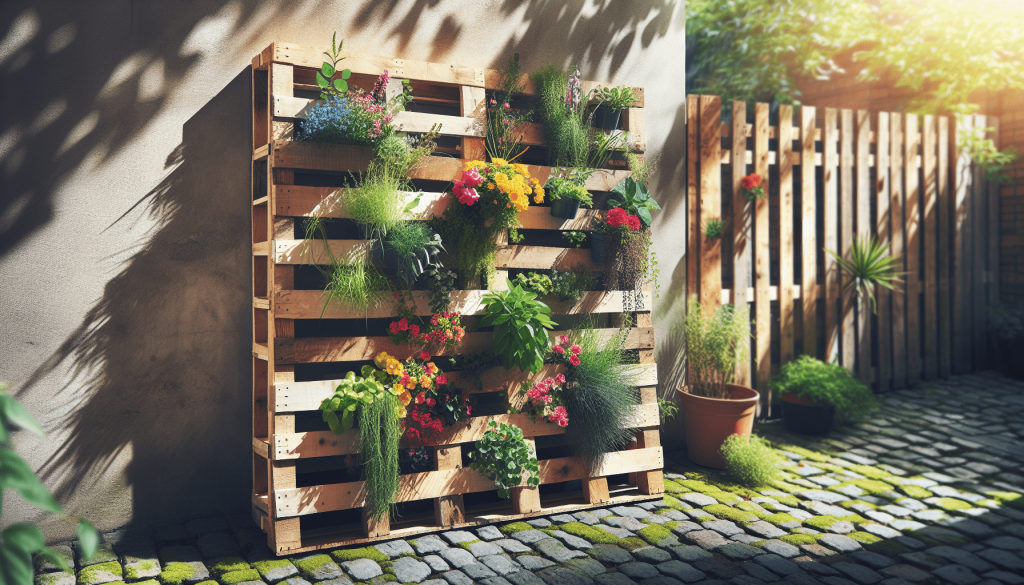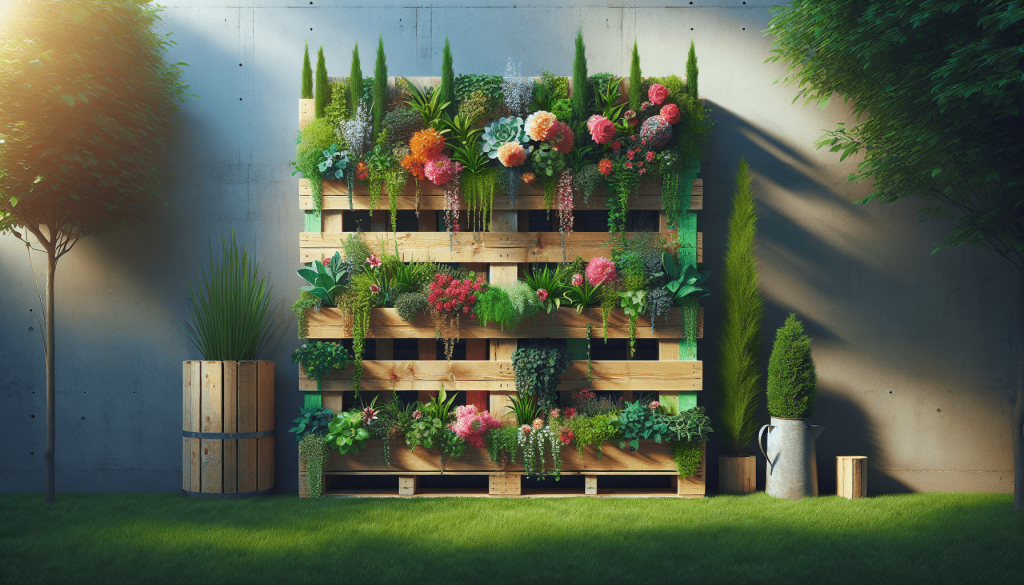This post may contain affiliate links. As an Amazon Associate, we may earn commissions from qualifying purchases.
How Can I Create A Vertical Garden Using Repurposed Materials?
Have you ever looked at a pile of old things and thought, “What if I could transform this junk into something beautiful?” Well, you can! Creating a vertical garden using repurposed materials is not only environmentally friendly but also a fantastic way to exercise your creativity. Intrigued? Let’s get started.
Why Opt for a Vertical Garden?
Vertical gardens save space, which is a blessing if you’re living in an urban area. They also offer a great way to grow more plants when horizontal space is at a premium. Less bending over means less backache, a definite bonus if you’ve spent years leaning over traditional garden beds.
Benefits of Vertical Gardens
The magic of vertical gardens lies in their ability to utilize unused space efficiently. Whether it’s a wall, a fence, or even the side of a shed, vertical gardens allow you to grow herbs, flowers, and even some vegetables.
- Space-Saving: Perfect for limited spaces.
- Aesthetically Pleasing: Vertical installations can convert drab areas into visual feasts.
- Easier Maintenance: Watering and harvesting can be more accessible.
Choosing Your Materials
So, what can you use? Almost anything! The trick is to reimagine how an old item can transform into a useful component of your vertical garden. It’s also about finding what’s readily available to you.
Commonly Repurposed Items
Here are some ideas:
- Wooden Pallets: These are a favorite due to their sturdiness.
- Plastic Bottles: Lightweight and easy to customize.
- Old Gutters: Surprisingly efficient for small plants.
- Picture Frames: Create an eye-catching, wall-mounted display.
- Old Dressers: Each drawer can serve as a planting box.
Gathering Your Materials
Before you hit the street searching for discarded items, take a mental inventory of what you already have at home. Items stuck in the back of your shed might work perfectly for this project. If you need more stuff, check out local thrift stores, garage sales, or online marketplaces.

Planning Your Vertical Garden
Planning is essential. Sketch your ideas on paper first. Visualizing the final product will make it easier to make decisions as you go along.
Sketching and Measuring
Sketch your design. Consider practical aspects like:
- Sunlight Exposure: Ensure your garden will get adequate light.
- Watering System: Think about how you’ll water your plants.
- Weight Bearing: The structure should support the weight of the soil and plants.
Choosing Plants
Not all plants are created equal. Some are better suited for vertical gardening than others. Here are a few examples:
| Plant Type | Description |
|---|---|
| Herbs | Basil, Mint, Parsley – easy to grow and maintain. |
| Succulents | Hardy plants that require minimal maintenance. |
| Flowers | Petunias, Begonias, Miniature Roses – brightening up any space. |
| Leafy Greens | Spinach, Lettuce, Kale – great for quick harvest cycles. |
Soil and Fertilizers
Opt for a light but nutrient-rich growing medium. Consider a mix of compost, coco coir, and perlite. Also, be mindful of fertilizers. Organic options are preferable to keep your garden eco-friendly.
Constructing the Frame
So, you’ve gathered your materials and made a plan. It’s construction time! Let’s go through a few popular options.
Building with Wooden Pallets
Wooden pallets are ubiquitous and perfect for vertical gardens.
- Preparation: Sand down and clean your pallet to avoid any splinters.
- Painting: Optional but adds a nice touch and provides extra wood protection.
- Lining: Staple landscape fabric to the back and sides. This keeps the soil from falling through.
- Filling: Fill each section with soil catered to your plants.
- Planting: Arrange your plants, considering the requirements of each.
Crafting with Plastic Bottles
Plastic bottles are another fantastic option, readily available and easy to work with.
- Cutting: Cut the side of the bottle lengthwise, creating an opening for soil and plants.
- Draining: Poke some holes at the bottom for drainage.
- Mounting: Attach them to a sturdy surface using screws, nails, or even zip ties.
- Filling: Fill with a soil mixture suitable for your plants.
- Planting: Place your plants into the bottles.
Using Old Gutters
Repurposing old gutters can give your garden a sleek and modern look.
- Cleaning: Thoroughly clean the gutters to remove any debris.
- Drilling: Drill holes for drainage at regular intervals.
- Mounting: Attach them horizontally on a wall.
- Filling: Add soil compatible with your chosen plants.
- Planting: Add your greenery and watch it thrive.

Installing the Irrigation System
Watering a vertical garden can be tricky due to its upright nature. You’ll need an efficient system to ensure all your plants get the moisture they need.
Drip Irrigation
One of the best solutions is a drip irrigation system. It’s economical and ensures even watering.
- Installation: Secure tubing along each row or level, and connect it to a water source.
- Emitters: Insert emitters where the water should drip out.
- Timer: Attach a timer to automate the watering process.
Manual Watering
If you prefer a more hands-on approach, use a watering can with a long spout to reach higher levels. Ensure to water slowly to avoid soil erosion.
Adding the Final Touches
You’ve built your garden and set up the watering system. What’s next? It’s all about the details now, making sure your garden is as functional as it is beautiful.
Decorations
Add ornaments or decorative pieces to enhance the overall look. Consider:
- Fairy Lights: Make it look magical at night.
- Paint: Use weather-resistant paints to add some color.
- Labels: Create cute labels to identify each plant.
Maintenance
Keeping your vertical garden looking fresh requires some upkeep.
- Pruning: Regularly trim your plants to keep them healthy.
- Feeding: Use organic fertilizers to feed your plants.
- Monitoring: Keep an eye out for pests and diseases.
Troubleshooting Common Problems
We all know that the best-laid plans can sometimes go awry. Here are some common issues you might face and how to tackle them.
Uneven Growth
Plants on the lower levels may get less sunlight. If you notice uneven growth:
- Rotate Plants: Periodically rotate the plants to even out exposure.
- Supplement Light: Use grow lights if natural light is insufficient.
Watering Issues
Too much or too little water can harm your plants.
- Check Soil Moisture: Use a moisture meter to gauge when to water.
- Adjust Irrigation: Tailor the drip intervals based on plant needs.
Pests
Pesky intruders can ruin your hard work.
- Natural Pesticides: Use natural solutions like neem oil.
- Companion Planting: Grow pest-repellent plants like marigolds.
Success Stories: Real People, Real Vertical Gardens
Everyone loves a good success story. Let’s look at a couple of inspiring examples of people who turned trash into vertical treasure.
Sally’s Bohemian Oasis
Sally, a city dweller with a passion for plants, transformed her tiny balcony into a vertical garden paradise using old picture frames. She cleverly arranged succulents within the frames, creating a living piece of art. Sally says, “My balcony went from drab to fab with just a few frames and some creativity.”
Tom’s Gutter Veggie Patch
Tom, who lives in a small townhouse, decided to use old house gutters to grow his vegetables. Mounted on the side of his home, Tom’s innovative garden now supplies him with fresh lettuce, spinach, and even cherry tomatoes. “I never thought old gutters could be this useful. It’s been a game-changer,” he shares.
Making Your Vertical Garden Sustainable
Environmental consciousness extends beyond using repurposed materials. Here are ways to make your garden even more eco-friendly.
Water Conservation
Use rain barrels to collect and store rainwater. Use this water for your garden to reduce dependency on municipal sources.
Composting
Turn your kitchen scraps into compost. This not only reduces waste but also enriches your garden soil.
Native Plants
Opt for native plants that require less water and care, and are naturally disease-resistant.
Reusable Containers
If a plant outgrows its initial container, repurpose another old item instead of buying new pots.
Conclusion: The Joy of Creating
Creating a vertical garden using repurposed materials is not just a hobby—it’s an adventure. It’s about seeing potential in the forgotten, and beauty in the discarded. You’ll not only contribute to a healthier planet but also enjoy the satisfaction of creating something uniquely yours. Ready to rummage through that garage or thrift store? Your new vertical garden awaits.
Questions? Ideas? We’d love to hear your thoughts on creating a vertical garden with repurposed materials. Embrace the joy of transforming the ordinary into the extraordinary, one plant at a time.








